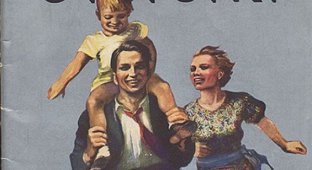Posters and advertisements with photographs of babies wrapped in cellophane seem strange to us now. But 70 years ago, cellophane was a new product in the West, advertised as a universal packaging product. We were 50 years late. In the USSR, plastic bags began to come into use in the late seventies. Before this, products were packaged in paper.
Cellophane advertising from the 1930s to the 1950s.

Sheets of cellophane from gifts were carefully folded, in order to, in turn, beautifully pack your present. Grocery bags were washed and dried, and large plastic bags were almost a cult item in the USSR in the 70s. Scotch tape was brought from abroad as a gift! It was definitely not on sale in the 70s, as far as I remember. We took care of the packaging from imported equipment, especially polyethylene with bubbles, which was folded and stored.

Cellophane is a material made from wood cellulose. His invention, as often happens, was a matter of chance. In 1911, a Swiss chemist tried to invent a coating for tablecloths that would protect them from stains. The result of his experiments was a moisture-permeable transparent film - this was cellophane.

The first industrial production of this material was established in France in 1913, and 11 years later the DuPont company acquired the technology and, having patented it, began producing cellophane the following year.


Food

Thus, a new character appeared on the packaging scene - a transparent, moisture- and air-tight film suitable for storing food products.

The freshness of the product contained in cellophane was no longer as illusory as the first two qualities. Cellophane film, due to its tightness, really helped preserve the freshness of the product, which was especially noticeable when packing cut meat in film.


Cellophane, the Flavor Saver! 1936

Another advantage of cellophane is that its packaging allows the buyer to hold the product in his hands and examine it from all sides without compromising the presentation of the product.
If previously a buyer could not pick up, for example, a bun from the counter, and then put it back and leave, then with the advent of buns packaged in cellophane, this became possible.


Ad-cellophane packaged bread 1940
"Cellophane by DuPont
"Fresh! Just like this bread in cellophane!
Cellophane made it possible to examine the product without opening the package, which significantly stimulated sales and increased the number of so-called accidental purchases, that is, purchases made under the influence of fleeting desires. Products in cellophane packaging aroused such desires more often than products in cardboard.
In addition, cellophane packaging carried three more qualities: shine, cleanliness and freshness.
Glitter surrounds the product with a kind of magical halo, creates a feeling of novelty of the product, and attracts the eye.

The buyer, of course, realizes that it is not the product itself that shines, but this does not prevent him from choosing a product in shiny packaging. There are known cases when, in order to revive sluggish trade in a store, products were wrapped in cellophane and trade went several orders of magnitude faster.







Tobacco and cigarettes



Hygiene

DuPont Cellophane 1938
"I never buy handled hosiery... heaven protect silk stockings from careless hands of shoppers and clerks!
The use of cellophane packaging gives the buyer confidence in the purity of the product. This effect was especially clear when children's toys were packaged in cellophane. It seemed to the parents that no one’s hands had ever touched the toys taken out of the sealed plastic packaging.

Children

In The 1950's, Advertisers Thought It Was A Good Idea To Wrap Babies In Cellophane

70 years ago, the plastic wrap was considered to be a thrilling novelty, as shown by these bizarre adverts touting the versatile product.

Scotch
There are several versions of where the name "scotch" came from. According to one of them, the Americans called adhesive tape scotch tape (English: scotch - Scottish), since at that time there were legends about Scottish stinginess, and the glue was initially applied in adhesive tape only along the edge.

Vintage Scotch Cellulose Tape packaging (pre-mid ’40s).
In 1925, Richard Drew got a job as a laboratory technician at the Minnesota Mining and Manufacturing company, which produced sandpaper.

Management assigned him to oversee the testing of a new model of Wetordry sandpaper in stores and car repair shops. Once, while in one of these workshops, he noticed that when painting cars with two or more colors, the dividing lines were sloppy.
He promised the painter to come up with something. Drew brought 2-inch-wide adhesive tape to the auto repair shop for testing. The painter decided to use a prototype, but when he started applying a different color, he noticed that the tape was warping. Taking a closer look, the painter realized that, in order to save money, the glue was applied only to the edges of the tape, and informed the inventor about this.
But, since there was no funding, only a few years later Drew began refining his invention. And on September 8, 1930, a prototype of the tape was sent for testing to a client in Chicago. The results met all expectations and costs.

1949
Scotch tape was originally used to wrap food, but during the Great Depression people came up with many other uses for tape.

Scotch tape was originally intended to seal food wrappers. It was to be used by bakers, grocers and meat packers. But people, forced to save money during the Great Depression, themselves came up with hundreds of new ways to use tape at work and at home: from sealing bags of clothes to storing broken eggs. It was then that the tape met torn pages of books and documents, broken toys, windows that were not sealed for the winter, and even dilapidated banknotes.

Make home repairs easier with Scotch Cellophane Tape 1949

1950's
The first countertop dispenser belt, introduced in 1932, was made of cast iron. She weighed about seven kilograms! Seven years later, the company released the snail, a portable tape dispenser. The original version was made from stamped sheet metal, with plastic models appearing in 1940.

Tape_dispenser
In 1932, John Borden improved the tape by providing it with a feeder with a blade for cutting a piece of tape with one hand.

This shape allows you to avoid constantly searching for the end of the tape.
Polyethylene
In the USSR, plastic bags were a symbol of inclusion abroad.
In the 1970s, plastic bags in the Soviet Union were mostly available from black marketeers.
In the passage on Arbat in Moscow, gypsies were selling packages. There were several other well-known points where you could buy scarce and very fashionable plastic bags; in Moscow they were sold in the toilets on Stoleshnikov and Petrovka.


The packages were priced pretty decently: from 3 for Pugacheva and Boyarsky (many people went with them in the 70s) to 15 rubles for a beautiful “branded” package.
With real foreign packages, there was no shame in walking around, showing off your foreign item to the envy of other passers-by.
People did not know imported brands and proudly walked around with bags of cheap Western chains.
In the Soviet Union, plastic bags were by no means disposable packaging, but were carefully stored and looked after. To reduce the load, a more worn one was inserted into a new bag; there were “out” bags, they were pre-glued and reinforced so that they would not tear. The especially beautiful ones were restored, it was a whole science!
Washing bags was common. The large ones were on strings along with the laundry, and the small ones for food were dried on the tiled wall.
Also, some of the youth walked around with bags made of fabric or burlap, which usually depicted the Beatles, Dean Reed, later Demis Roussos, or the group Bonnie M, ABBA and others, as well as brands of foreign cigarettes: Marlboro, Winston, Camel, etc. Then these same pictures migrated to packages produced by Caucasian “guild workers”.
But most people almost always carried string bags with them. They were comfortable, but they terribly rubbed my hands and tore my tights. There were even special plastic things where string bag handles were inserted to prevent calluses.
By the way, now string bags are back in fashion in the West, we have a store called “String Bags” in the arch, people buy them with pleasure.
More on the topic:



Posts about the history of familiar things - meat grinders, washing machines, stoves, irons, cash registers, hair dryers, vacuum cleaners:






























